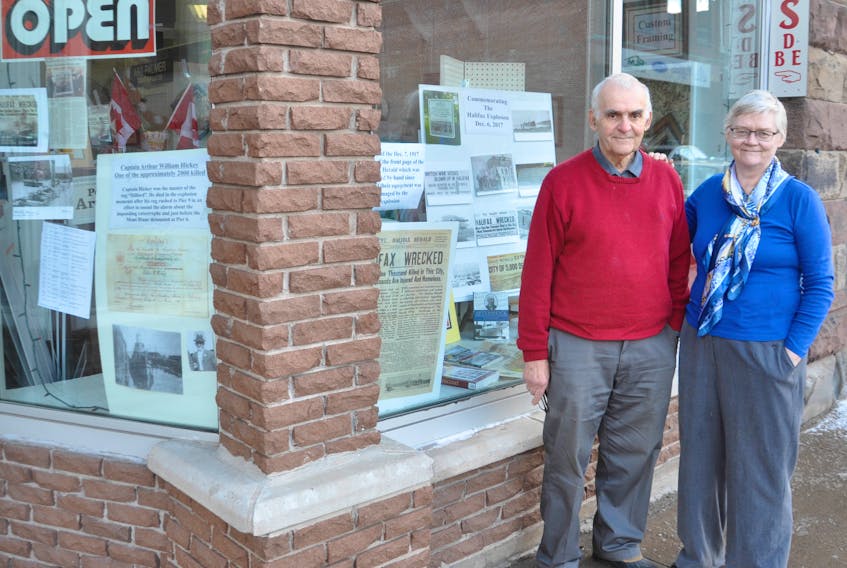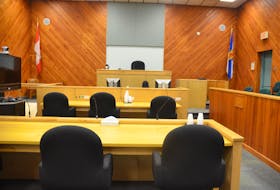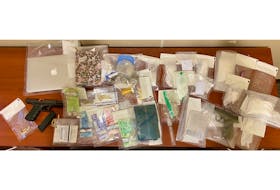Shortly after Art Palmer joined the Masons, he received a package in the mail.
He opened it and out fell a masonic ring.
The ring, he would learn, was once worn by his grandfather, Arthur William Hickey, who died in the Halifax Explosion on Dec. 6, 1917.
The landlady of the boarding house Hickey had been staying at found the ring, which he must have taken off his hand to wash and left behind. The woman sent the ring to Hickey’s wife. When she died, one of Palmer’s aunts took possession of the ring and promised to give it to the first grandson to join the Masonic Lodge.
A century after the explosion that claimed Hickey’s life, Palmer wears the ring with pride.
Palmer said there was little talk about the Halifax Explosion in his family growing up, with the loss presumably too raw to talk about, but he has been able to do some research and pick up some information from what he was told.
From what he’s learned his grandfather was a tugboat captain in North Sydney when the ship he worked on was commandeered for use by the British navy.
On the day of the explosion he was on a tugboat in the Bedford Basin with Lt. Commander James Anderson Murray.
When they saw the fire aboard the Mont Blanc at Pier 6 they immediately headed toward Pier 9 to attempt to warn people on shore about what was happening.
“Nobody would have known what was on the Mont Blanc except the chosen few,” Palmer said. Murray would have been one of those few.
According to some stories he heard, Murray took a running jump off the tug as it reached the pier and landed on the dock. He met a sailor and told him to spread the alarm and then went in the government telegram office where one of the two people working was Vince Coleman who is credited with sending a warning telegram in time to stop an incoming train filled with passengers.
While Palmer has no way of confirming if that was true, he said it makes sense.
“Vince Coleman wouldn’t have known what was on the boat without being told. It rings true.”
He said he’s always been impressed by Murray’s heroism.
“My reaction would be to head back to the Bedford Basin,” he said.
Instead Murray and his crew sailed further into the eye of the explosion. When the Mont Blanc exploded the tugboat was blown out of the water and landed on the land. While there were a couple of survivors on board the tugboat, Hickey was not one of them.
New Glasgow’s part in the relief following Halifax Explosion
The Halifax Explosion occurred at about 9:05 in the morning on Dec. 6, 1917.
Very soon after the explosion, a telegram was received in New Glasgow requesting urgent help in the form of surgeons, nurses and equipment.
The New Glasgow civic authorities were quick to respond. Within an hour after receiving the call for help, eight nurses and five New Glasgow surgeons boarded a special train and left the New Glasgow railway station at 11 a.m. On the same evening, another special train headed for Halifax stopped at the New Glasgow Railway Station and other New Glasgow medical doctors and nurses boarded the train.
New Glasgow surgeon Dr. George Hastings Cox, an eye, ear, nose and throat specialist, was one of the surgeons who was quick to head to the call for help. In Halifax and with the patients under chloroform aesthesia, Dr. Cox was reported to have performed 75 enuculations (the removal of the eye that leaves the eye muscles and remaining orbital contents intact) and five double enuculations in four days.
Starting on Friday, Dec. 7, and within 24 hours, the West Side School was transformed into an emergency hospital. Twelve classrooms were cleared of desks and furniture and fitted up as hospital wards with approximately 160 beds complete with all necessities including linen. The emergency hospital received approximately 100 wounded patients from the explosion. Many of these patients transported by train from Halifax to New Glasgow were severe surgical cases. Home accommodations in New Glasgow were provided for the patients who recovered.
New Glasgow’s prized steam fire engine, the Lulan, together with hose and other equipment, were loaded on a flat car and by train sent to Halifax. A volunteer crew together with 17 citizens of New Glasgow accompanied the Lulan.
COMPILED BY CLYDE MACDONALD









